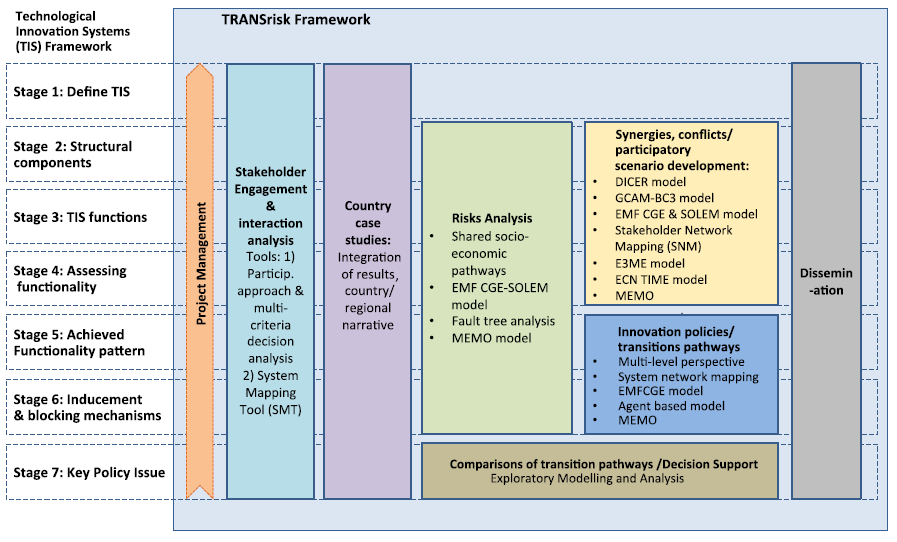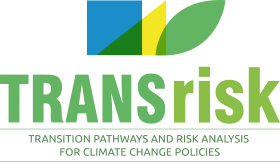New frameworks and tools are provided by TRANSrisk to manage climate change policy and are designed within the context of national case studies. Technological Innovation Systems (TIS) approach is used to explain the rate and nature of technological change in the case studies. The TRANSrisk project has two additional sectors alongside the four conventional circular economy sectors. A cross-sectoral approach is used to explore synergies and conflicts and risks and uncertainties of various innovative low
TRANSrisk aims to provide new frameworks and tools to manage climate change policy, emphasising on the need to realistically account for the inevitable risks and uncertainties that attend policy design. These frameworks and tools are discussed within the context of national case studies, at different levels of detail. The case studies are narratives that help to weave together empirical and modelling results. The selected case studies represent a sample of different political and environmental contexts within the EU states, and a sample of non-EU countries, covering the two largest Asian emitters (China and India), Africa, plus South and North America. The results from the case studies will be transferred to the broader modelling framework in two main ways: by helping construct and parameterise the models in relation to the functioning of the economy; and by running policy simulations in relation to policy impacts.
In order to bind these case studies together, the action draws upon the Technological Innovation Systems (TIS) approach, which involves exploring the interconnectivity, co-benefits and trade-offs between policies and institutions, technologies, environment, and society within a transition pathway. Typically, the TIS framework begins with a systematic identification of structural components of the system and the interactions between actors, networks and institutions. This is followed by assessing the functionality of the system by exploring market development, resource mobilisation, legitimisation, and other external economic factors. Then, the TIS approach investigates inducing and blocking mechanisms. Finally, key policy issues are raised accordingly. TRANSrisk applies components of the TIS structure by mapping them onto its work packages. Figure 1 illustrates the TRANSrisk framework and how the work packages are integrated into the typical stages within the TIS framework.

The TRANSrisk TIS Scoping Matrix
More particularly, in TRANSrisk project the TIS matrix is a scoping exercise that was carried out by all country case study partners with the aim to narrow the area studied, as well as to identify potential interactions between the socio-economic sectors and the natural environment (resources). The four conventional sectors of the circular economy identified are: the energy system, the agriculture and food system, the buildings system, and the transport system. The TRANSrisk project has two additional sectors including the service sector (health, education and tourism) and manufacturing sector to reflect the socio-economic areas the country case studies intend to cover. The environment is categorised by resource areas according to the Roadmap to a Resource Efficient Europe (COM(2011) 571). There are eight (8) resource classifications: materials and minerals, water, air, land, marine, ecosystems (biodiversity), forests and wastes.
All case studies explore the energy system as a starting point. The inclusion of other socio-economic sectors and resources enables researchers to explicitly identify interactions that would not be typically explored when studying the energy innovation system. The TIS matrix is a simple yet systematic process that helps to identify the potential interactions across sectors and help researchers to begin to assess how potential interactions could in turn impact resource uses. This analysis is intended to guide researchers towards a cross-sectorial and interdisciplinary approach rather than to focus on a conventional sector specific approach. The cross-sectorial approach is necessary to explore synergies and conflicts, as well as risks and uncertainties of various innovative low carbon transition pathways.
The current version of the TIS scoping matrix covers the wider social economy (e.g. health, education) and environment resources (resource area), explicitly drawing links between human well-being and environmental well-being. Figure 2 below provides an overview of the coverage of socio-economic areas and resources in each case study.
Further details on the potential interactions between the socio-economic sectors and resources are discussed in the TRANSrisk report “D3.1 Matrix of technological innovation systems selected for 15 cases studies”.
Resources and Further Steps
The identification of potential interactions is based on preliminary secondary research and on inferences made within the national/regional context (e.g. current events). As the project progresses, further secondary and primary research (including stakeholder engagement) will lead to additional insights and the identification of more complex synergies and conflicts.
All case studies cover the energy sector and at least two or more socio-economic sectors. Every case study has also identified materials and minerals as a resources area to study, since energy production requires the extraction and/or use of natural minerals. Due to the limited study on coastal regions, only one case study will explore marine resources. However, the majority of case studies have identified potential interactions with five or more resources. The case studies may not necessarily carry out an in-depth investigation of each interaction but acknowledge the complexity across various domains when considering risks and uncertainties.
About This Article
This article is an output of the EU-funded TRANSrisk project. It is derived from work undertaken for Deliverable “D3.1 Matrix of technological innovation systems selected for 15 cases studies” of the TRANSrisk project. This deliverable, and other TRANSrisk outputs can be downloaded from the project website (http://transrisk-project.eu/content/transrisk-results).

TRANSrisk
Project details
- Project title: “Transitions Pathways and Risk Analysis for Climate Change Mitigation and Adaption Strategies” (TRANSrisk)
- Funding scheme: European Union Horizon 2020 Programme (EU H2020, grant agreement no. 642260)
- Duration: 3 years (1 September 2015 – 31 August 2018)
- Project coordinator: Science Policy Research Unit, University of Sussex, United Kingdom
- Project website: www.transrisk-project.eu

